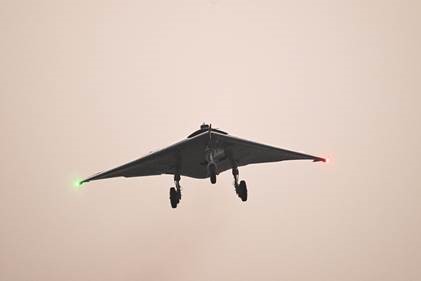Description

Disclaimer: Copyright infringement not intended.
Context
The successful flight trial of the Autonomous Flying Wing Technology Demonstrator by the Defence Research and Development Organisation (DRDO) is a momentous achievement in India's aeronautical advancement.
Details
- Technology Mastery: The flight trial marks India's entry into an exclusive league of nations capable of maneuvering flying wing technology in a tailless configuration, demonstrating exceptional control and proficiency in this specialized field.
- Development Origins: The UAV was conceived and crafted by DRDO's Aeronautical Development Establishment. The journey began with its maiden flight in July 2022, followed by a series of six meticulously planned flight trials.
- Design and Material Excellence: The aircraft's construction utilized lightweight carbon prepreg composite material, a remarkable display of India's indigenous expertise in aerospace technology.
- Autonomous Features: The UAV demonstrated autonomous landing capabilities without relying on ground radars, infrastructure, or human pilots. Its unique ability to take off and land from runways with pinpoint accuracy was facilitated by sensor data fusion and GPS Aided GEO Augmented Navigation (GAGAN) receivers, ensuring precise navigation.
- Technological Sovereignty: India's adeptness in developing cutting-edge technology like the Autonomous Flying Wing UAV signifies a significant leap towards self-sufficiency and technological sovereignty in the realm of advanced aerospace technology.

About Flying-wing UAVs
- They represent a unique and advanced category of unmanned aircraft characterized by their distinct wing design, which merges the body of the aircraft into a single, wing-shaped structure, without any separate tail or fuselage.
- These UAVs are engineered to provide a myriad of applications across various fields due to their innovative design and versatile capabilities.
Design and Features:
- Wing Configuration: The most prominent feature of a flying-wing UAV is its wing configuration, which is the primary structure and contributes to both lift and stability.
- Stealth and Low Radar Signature: The design of flying-wing UAVs often aims for reduced radar cross-section, providing stealth characteristics that make them less detectable by radar systems.
- Payload Capacity: These UAVs can accommodate various payload configurations, including sensors, cameras, communication devices, and sometimes even weapons, depending on the intended purpose.
- Long-Endurance Flight: Due to their efficient aerodynamics, flying-wing UAVs can achieve extended flight times and long endurance, making them suitable for surveillance, reconnaissance, and monitoring missions.
- Control Systems: Advanced control systems and fly-by-wire technology ensure stability and precise control, enabling autonomous or remotely piloted flights.
Applications:
- Surveillance and Reconnaissance: Flying-wing UAVs excel in intelligence gathering, surveillance, and reconnaissance missions. Their stealthy design and endurance capabilities make them suitable for long-duration aerial surveillance tasks.
- Military Operations: They have applications in military scenarios for reconnaissance, target acquisition, and potential deployment as combat drones.
- Civilian Uses: In civilian domains, they find use in environmental monitoring, disaster management, agriculture, and infrastructure inspection.
- Communications Relay: Some variants serve as high-altitude communications relays for extending network coverage or supporting communication in remote areas.
- Research and Development: Flying-wing UAVs are also employed in research and development for advancing aerospace technology and testing new aerodynamic designs.

Conclusion
Flying-wing UAVs represent a cutting-edge evolution in unmanned aerial technology, offering a blend of stealth, endurance, and adaptability for diverse applications across military, civilian, and research sectors. Further advancements in design, control systems, and regulatory frameworks will continue to shape their role in the future of aerial operations and technological innovation.
MUST READ ARTICLES:
https://www.iasgyan.in/daily-current-affairs/unmanned-aerial-vehicle-uav
|
PRACTICE QUESTION
Q. Discuss the significance of the successful flight trial of the Autonomous Flying Wing Technology Demonstrator by DRDO for India's defense and technological advancements. What does this accomplishment reflect in terms of indigenous aerospace capability and strategic implications for the country's armed forces? (250 Words)
|










